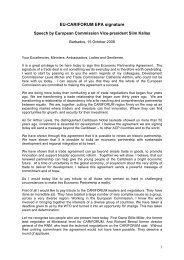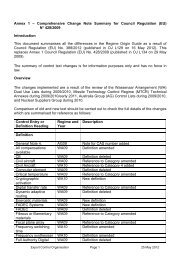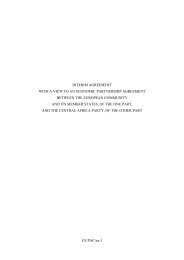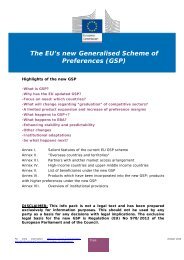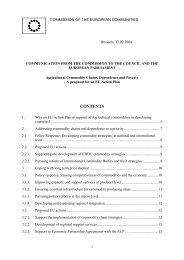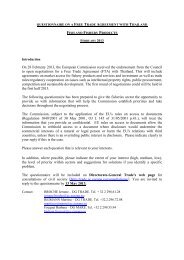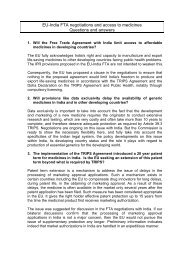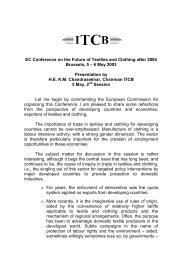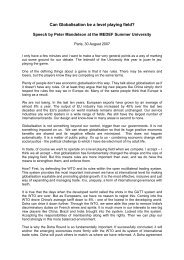Report on the Implementation of the derogation to ... - Trade Websites
Report on the Implementation of the derogation to ... - Trade Websites
Report on the Implementation of the derogation to ... - Trade Websites
Create successful ePaper yourself
Turn your PDF publications into a flip-book with our unique Google optimized e-Paper software.
Final <str<strong>on</strong>g>Report</str<strong>on</strong>g><br />
RoO Derogati<strong>on</strong> under <strong>the</strong> PACP-IEPA<br />
6.7 Third Country Processors<br />
Exporters <strong>of</strong> processed tuna <strong>to</strong> <strong>the</strong> EU are competing in a multi-billi<strong>on</strong> euro market. French<br />
investment in overseas processing c<strong>on</strong>centrated in West Africa from <strong>the</strong> 1950s <strong>on</strong>wards until being<br />
taken over by o<strong>the</strong>r players in <strong>the</strong> 1980s and 1990s. 294 Spanish investment focussed <strong>on</strong> Latin<br />
America from <strong>the</strong> mid-1970s <strong>on</strong>wards. Table 6.10 details <strong>the</strong> canned tuna and tuna loin producti<strong>on</strong><br />
capacity <strong>of</strong> <strong>the</strong> major countries supplying <strong>the</strong> EU with <strong>the</strong>se products. 295 As already noted, all <strong>of</strong><br />
<strong>the</strong>se countries except for <strong>the</strong> four Sou<strong>the</strong>ast Asian countries plus China have duty free access <strong>to</strong> EU<br />
markets (subject <strong>to</strong> regulati<strong>on</strong>s <strong>on</strong> RoO, SPS and IUU). On <strong>the</strong> <strong>on</strong>e hand, for all <strong>of</strong> <strong>the</strong>se countries,<br />
tuna processing capacity is also deployed <strong>to</strong> supply n<strong>on</strong>-EU markets. Market diversificati<strong>on</strong> is a<br />
central strategy for some Asian producers. 296 For example, Thailand, Ind<strong>on</strong>esia, <strong>the</strong> Philippines and<br />
China are major suppliers <strong>of</strong> canned tuna <strong>to</strong> <strong>the</strong> US market, 297 and <strong>the</strong> EU market was <strong>on</strong>ly 13% in<br />
volume <strong>of</strong> <strong>to</strong>tal Thailand exports in 2010. 298 On <strong>the</strong> o<strong>the</strong>r hand, all <strong>of</strong> <strong>the</strong> Africa IEPA countries and<br />
PNG are highly dependent up<strong>on</strong> <strong>the</strong> EU market. The GSP+ countries sit somewhere between <strong>the</strong><br />
two, with significant sales <strong>to</strong> <strong>the</strong> US and in regi<strong>on</strong>al markets.<br />
It is bey<strong>on</strong>d <strong>the</strong> scope <strong>of</strong> this report <strong>to</strong> <strong>of</strong>fer full accounts <strong>of</strong> all third country processors. The<br />
following provides short accounts <strong>of</strong> some key elements <strong>of</strong> selected locati<strong>on</strong>s <strong>of</strong> producti<strong>on</strong> as <strong>the</strong>y<br />
relate <strong>to</strong> EU markets and/or investments by European firms.<br />
• All processors based in Thailand specialise in n<strong>on</strong>-branded processing except for Thai Uni<strong>on</strong>,<br />
which owns major canned tuna brands in <strong>the</strong> EU (Table 6.9) and Chicken <strong>of</strong> <strong>the</strong> Sea in <strong>the</strong><br />
US. N<strong>on</strong>e<strong>the</strong>less, Thai Uni<strong>on</strong> also c<strong>on</strong>tinues <strong>to</strong> undertake n<strong>on</strong>-branded processing for EU<br />
clients. Thailand provides an almost full range <strong>of</strong> tuna products – from standard canned tuna<br />
in vegetable oil or brine <strong>to</strong> a wide selecti<strong>on</strong> range <strong>of</strong> ‘value added’ items. In short, it is a<br />
‘<strong>on</strong>e-s<strong>to</strong>p shop’ for buyers needs. The <strong>on</strong>ly market segment where Thailand remains a minor<br />
player is canned yellowfin in olive oil in 80gm cans, <strong>the</strong> principal product <strong>on</strong> Italian and<br />
Spanish markets. Importantly, Thailand relies very heavily <strong>on</strong> tuna raw material imported<br />
from <strong>the</strong> WCPO (see Table 3.16).<br />
• PNG, Philippines, Madagascar, Ind<strong>on</strong>esia and Côte d’Ivoire all specialise in <strong>the</strong> n<strong>on</strong>-branded<br />
processing <strong>of</strong> basic canned tuna in vegetable oil and brine. PNG produces primarily for<br />
private label and hard discount s<strong>to</strong>res. As already noted, processors in <strong>the</strong> Philippines have<br />
experienced increasingly severe raw material supply c<strong>on</strong>straints since 2009.<br />
• Ghana and Seychelles produce standard canned tuna, mainly for Thai Uni<strong>on</strong>-owned brands,<br />
but also some private label. The Seychelles has <strong>on</strong>ly <strong>on</strong>e cannery and is orientated primarily<br />
<strong>to</strong> supply <strong>the</strong> EU market. Producti<strong>on</strong> in <strong>the</strong> Seychelles declined with <strong>the</strong> drop in tuna catch in<br />
<strong>the</strong> Western Indian Ocean in 2007 <strong>on</strong>wards. Its export volumes <strong>to</strong> <strong>the</strong> EU declined by 31%<br />
299<br />
294 Senegal was <strong>the</strong> first major site <strong>of</strong> European investment in canned tuna processing capacity (by French<br />
firms in <strong>the</strong> 1950s). Processing based <strong>the</strong>re has been in relative decline since <strong>the</strong> 1970s when <strong>the</strong> EU DWF<br />
shifted sou<strong>the</strong>ast in <strong>the</strong> Gulf <strong>of</strong> Guinea <strong>to</strong> establish its new main base in Abidjan, which processing investment<br />
so<strong>on</strong> followed. With <strong>the</strong> opening <strong>of</strong> <strong>the</strong> purse seine fishery in <strong>the</strong> Western Indian Ocean in <strong>the</strong> 1980s, French<br />
firms also invested in processing capacity in Madagascar and Seychelles . Campling 2012.<br />
295 This includes <strong>the</strong> countries listed in Table’s 6.2 and 6.6 above <strong>on</strong> extra-EU27 tuna loin and canned tuna<br />
imports respectively.<br />
296 Ferdouse 2011.<br />
297 Globefish 2010: 50.<br />
298 Chalisarap<strong>on</strong>g 2011. Thailand’s record volume <strong>of</strong> canned tuna exports <strong>to</strong> <strong>the</strong> EU occurred in 2006<br />
(84,431mt), it has declined since <strong>the</strong>n (see Table 6.6) but <strong>to</strong>tal canned tuna producti<strong>on</strong> in Thailand has<br />
increased. This also indicates a strategy <strong>of</strong> market diversificati<strong>on</strong>.<br />
299 For more detailed country-specific analysis <strong>of</strong> several <strong>of</strong> <strong>the</strong> locati<strong>on</strong>s <strong>of</strong> producti<strong>on</strong> detailed in Table 6.10<br />
see Campling et al. 2007, Campling and Doherty 2007, Barnes and Campling 2008 and Hamilt<strong>on</strong> et al. 2011.<br />
Linpico s.a.r.l. Page 146




